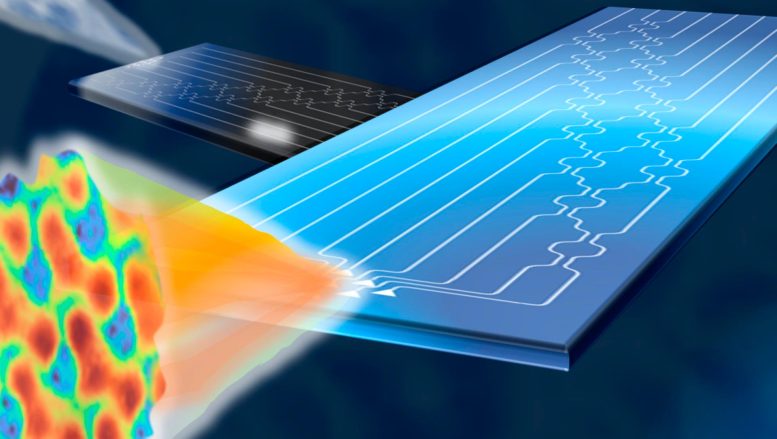
New advanced photonic chips have been developed that optimize light transmission for optical wireless systems. These chips, essential for future 5G and 6G networks, represent a shift towards energy-efficient analog technologies and have wide-ranging applications in high-speed data processing and communication. Credit: Politecnico di Milano
A new breakthrough in optical wireless technology features photonic chips that efficiently shape light for improved data transmission, pivotal for the advancement of future wireless networks and high-speed data processing.
Optical wireless may no longer have any obstacles. A study by Politecnico di Milano, conducted together with Scuola Superiore Sant’Anna in Pisa, the
Innovative Photonic Chip Technology
The devices developed in this research are small silicon chips that serve as smart transceivers: working in pairs, they can automatically and independently ‘calculate’ what shape a beam of light needs to be in order to pass through a generic environment with maximum efficiency. And that’s not all: they can also generate multiple overlapping beams, each with its own shape, and direct them without them interfering with each other; in this way, the transmission capacity is greatly increased, just as required by next-generation wireless systems.
Efficient and Advanced Processing
“Our chips are mathematical processors that make calculations with light very quickly and efficiently, almost with no energy consumption. The optical beams are generated through simple algebraic operations, essentially sums and multiplications, performed directly on the light signals and transmitted by micro-antennas directly integrated on the chips. This technology offers many advantages: extremely easy processing, high energy efficiency, and an enormous bandwidth exceeding 5000 GHz,” Francesco Morichetti Head of the Photonic Devices Lab of Politecnico di Milano, explains.
Shift Towards Analog Technologies
“Today, all information is digital, but in fact, images, sounds, and all data are inherently analog. Digitization does allow for very complex processing, but as the volume of data increases, these operations become increasingly less sustainable in terms of energy and computation. Today, there is great interest in returning to analog technologies, through dedicated circuits (analog co-processors) that will serve as enablers for the 5G and 6G wireless interconnection systems of the future. Our chips work just like that,” Andrea Melloni, Director of Polifab, Politecnico di Milano’s micro and nanotechnology center, says.
Applications in Various Fields
“Analog computing using optical processors is crucial in numerous application scenarios that include mathematical accelerators for neuromorphic systems, high-performance computing (HPC) and artificial intelligence, quantum computers and cryptography, advanced localization, positioning and sensor systems, and in general, in all systems where the processing of large amounts of data at very high speed is required,” adds Marc Sorel, Professor of Electronics at the TeCIP Institute (Telecommunications, Computer Engineering, and Photonics Institute) of Scuola Superiore Sant’Anna.
Reference: “Determining the optimal communication channels of arbitrary optical systems using integrated photonic processors” by SeyedMohammad SeyedinNavadeh, Maziyar Milanizadeh, Francesco Zanetto, Giorgio Ferrari, Marco Sampietro, Marc Sorel, David A. B. Miller, Andrea Melloni and Francesco Morichetti, 23 November 2023, Nature Photonics.DOI: 10.1038/s41566-023-01330-w
The work is co-funded under the NRRP by the RESTART research and development program ‘RESearch and innovation on future Telecommunications systems and networks, to make Italy more smart’. Within the RESTART program Prof. Andrea Melloni, Politecnico di Milano, and Prof. Piero Castaldi, Istituto TeCIP, Scuola Superiore Sant’Anna Pisa lead the ‘HePIC’ focused project and ‘Rigoletto’ structural project, which aim to develop next-generation photonic integrated circuits and optical transport networks that will support the future 6G infrastructure.